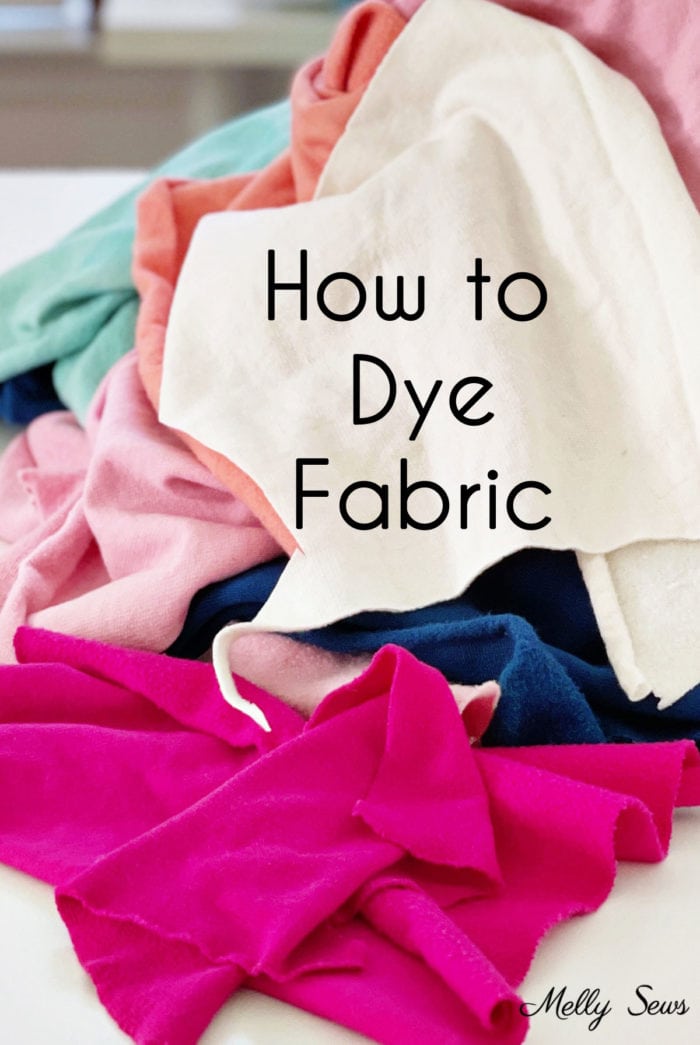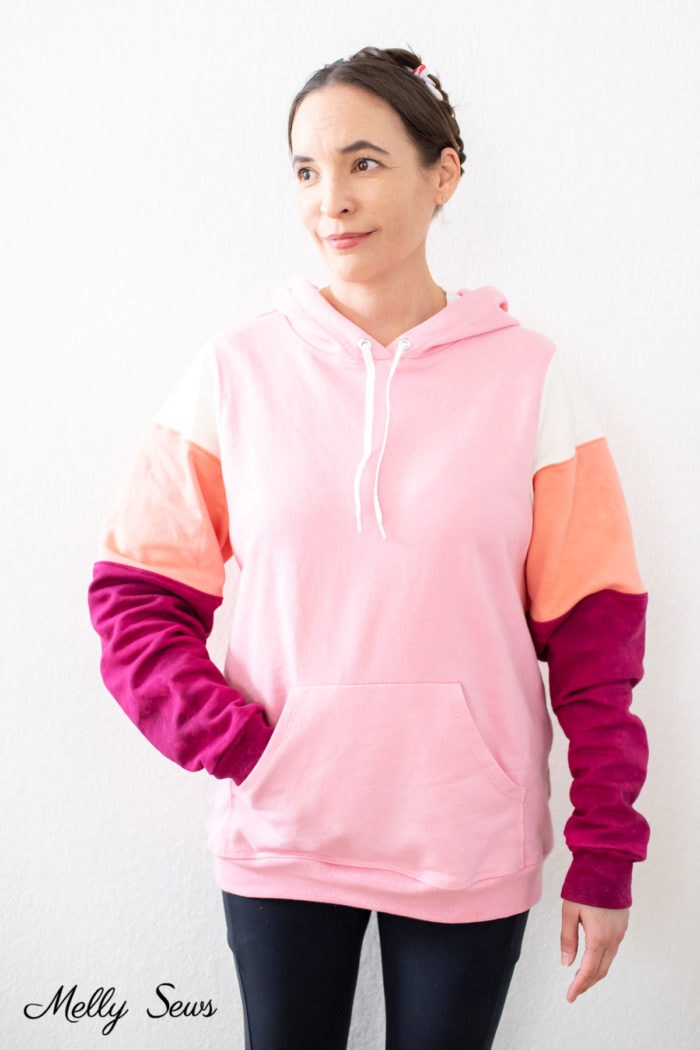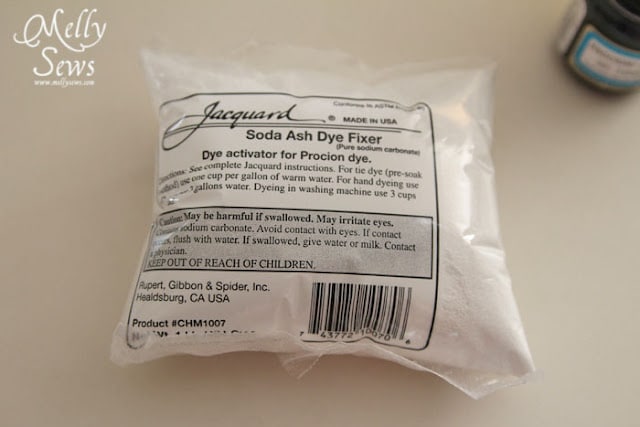How to dye fabric in bright, vibrant, and colorfast shades

Hey y’all, today we’re going to talk about how to dye fabric and end up with beautiful, colorfast color.
One of the reasons I sew (and knit) is because I have found it to be the most economical way to get EXACTLY what I want. I’m a picky girl, and when I decide I want something, I want exactly that thing. (See for example the Toddler Blazer pattern – the whole reason I made it was because I couldn’t find a ready-made blazer in the color and size I wanted. Then I couldn’t even find a ready made pattern to make my own blazer. Frustrating at the time, but wonderful in hindsight since it’s still my top-selling pattern)
Me always wanting what I want and then being unable to find it often spills over to fabric. So I do a lot of dyeing, which (hopefully) isn’t at first apparent by looking at my creations (unless I want it to be, like an ombre technique).
Hand Dyed Projects
Some of the things I’ve dyed and posted about:
These Clean Slate Shorts:

This Ruched Ombre Dress (twice!)


And the fabric for this Little Bow Pleat Dress

And both the items from this yet-to-be-revealed outfit

For all of those items, I used RIT dyes.
But…
With many of these projects I’ve been less than 100% pleased with the results. Particularly with the ombre dress, during which I went through at least three dye it, overdye it, bleach it, start again cycles. And I’m still not thrilled with the final results.
Hand Dyeing Problems
In a nutshell, there are two problems I’ve had with these dyes.
- They’re very hard to mix predictably. Even using the ColoRIT guide and test dyeing swatches, I can’t get predictable results. The Aquamarine (shorts and shirt cuff above) seems to be the only one I have had reliable, likeable results from. And only if I don’t mix the liquid dye.
- It is very hard to get deep, vibrant colors with these dyes, even using very hot water and salt and following directions to a T. And it becomes more difficult when you’re mixing dyes – that in particular seems to me to muddy the waters, so to speak, and give you duller colors.
In contrast, I have had great luck dyeing and painting yarn that I spin, including awesome results with Kool-Aid. But I don’t often sew with wool, and protein fibers (like wool) and plant fibers (like cotton) dye differently.
So, with my latest project (which was originally going to be my post for today) I went through the same angst I went through with the ombre dress and still didn’t like the results. So I decided to be a big girl and get some real dye and learn how to dye fabric with it. The kind of dye you have to go to the art supply store to get or order online. Dye that requires mixing chemicals. The kind that I have been scared to use.
And you know what? Like many fears, this one proved totally unfounded! So in case any of you are also disappointed with RIT and want to get better, more predictable color for your garment, read on.
Dyeing Secret – Procion Dyes
I used Procion MX Fiber Reactive Cold Water Dye. I have been avoiding this dye for a few reasons. (UPDATE: since this project I have exclusively used Dharma Trading Co. Procion Dyes, which you can get in more colors and are slightly cheaper and have given me awesome results as well.)
- You can’t get it at Joann or Michaels, or, to my knowledge, Hobby Lobby. I had to drive into town and go to the art store to get it. Or you can order it online. And while I love that there are 3 art supply stores here that carry it, I’m scared to go in those stores. Like I feel like they’re for “real” artists and I’m some kind of poser who will be immediately detected and thrown out. Well, my trip was perfectly easy and pleasant, and I didn’t detect any cynical staff members looking down their noses at me. Fear #1, completely unfounded.
- You have to use soda ash as a dye fixative to set the dye, and I feared this would be caustic and awful to handle and create terrible fumes. Oh, and also expensive. Well, I looked it up, and the greatest risk seemed to be storing it mixed with water, which I didn’t, or letting it touch your hands because it’s a skin irritant. So I wore rubber gloves, which I wear anyways when dyeing. Also it’s cheap and easy to handle and use. Fear #2 unfounded.
- I thought it would be ridiculously expensive. Truth: I spent a total of $28 on the supplies. Yes, that is a little pricey. But I only used about $4 worth of those supplies; the rest I have left over for next time (the priciest thing was the detergent at $19.99 because they didn’t have smaller sizes; I’m not sure you have to have that, but since it was my first time I followed directions to the letter ) (Update – 8 years after I wrote this post I’m still using the same bottle of Synthrapol – a little goes a long way per wash!). A bottle of RIT dye is $3.99. And that’s if I only use one bottle. With the ombre dress I went through 4 bottles by the time I was done. So in reality, this isn’t any more expensive, and I like the results so much better. Fear #3 busted.
- I thought the process would be time consuming and complicated. I had this vision of high school chemistry lab and things blowing up. It isn’t at all like that. Especially when you compare to the ridiculous process I went through to get the ombre dress to a color I don’t even love. You do have to be careful with the powder and make sure not to inhale it, but once you have it dissolved in water you don’t need any special precautions.
Below is a sweatshirt I dyed with a few colors of procion dye.

How to Dye Fabric with Procion Dyes
Want to know the actual dyeing process? You can find the detailed instructions here, but they boil down to this:
- Fill a tub, large pot or bucket with hot tap water (not warm water; you want this hot) and add a whole bunch of salt. The amounts – gallons of water, tablespoons of dye, vary based on how much fabric you’re dyeing and what color you’re using.
- Add the required amount of dye.
- Put in your prewashed and wet item to dye.
- Stir. After 20 min, add soda ash.
- Keep stirring occasionally for 50 more minutes. Rinse and wash.
See? It’s really nothing to be scared of. I have no idea why it took me so long! And I will not be going back to RIT dyes now that I know how to dye fabric with fiber reactive dyes. Note that procion dyes are for plant based fibers – cotton, linen, hemp, etc. Rayon fabric also works as the cellulose fibers are plant based even if it’s a man made fabric. Procion dyes will dye silk and wool, but not as vibrantly. For animal protein based fibers you want to use acid dyes for best results. And they don’t work on polyester or nylon. So if you’re dyeing store bought t-shirts, check the fiber content so you won’t be disappointed.
These are the supplies I bought:

Including that scary soda ash

Where I Dye Fabric
My washing machine is a front loader and I don’t really want dye in it anyway. So here’s how I set up my dyeing area: I use a big plastic storage tub set in my bathtub. I mix the dye and hot water in the plastic tub, then when I’m done I dump it into the bathtub to drain and rinse. I have an acrylic bathtub, and it’s important to rinse quickly or the dye kind of stains my tub, but it’s nothing I haven’t been able to get off with a little bleach later.
Note: the previous paragraph was how I set up dyeing in my old house. My current house has a utility sink in the laundry room, so I generally dye my fabrics in there now.
One thing I had trouble finding online is how much dye 2/3 oz. (the jar size) will dye. With most colors, it will do two and a half 3 gallon dye baths (a 3 gallon bath should dye 1 lb of dry fabric). Some colors need twice the amount of dye, so a jar will only do a little more than 1 dye bath. (Update: the Dharma dyes come with more dye in a jar than this and better instructions for dye amounts to use. Just order one jar and you should be fine for a couple items of clothing in that color).
Want to know what I dyed? Well, here’s a sneak peek:


UPDATE: Dyed project here

Joan
This is a super useful post. Thanks for allaying the fears of the rest of us. And for teasing us with the ‘oh it was too dark to take pictures line’. I’ll be back tomorrow to see what you’ve done with this!
Palak
That color is vibrant! I’ve never dies (aside from koolaid dyeing yarn), but I really want to try.
LisaRae
I love the colour of your last item ( looks like jeans to me)!
cathgrace
You really don’t need the synthrapol, although it really does help to remove the fugitive dyes, but as long as you rinse and rinse, you can get away without it – a pro tip I recently heard was that blue dawn (specifically the blue one) has the same ingredient in it that synthrapol has, so you can use it instead! (dharma trading also has a cheaper version in their own brand than the one you got.)
I would also recommend using thiox to remove color rather than bleach, since bleach is sooooo caustic to your fibers – it actually will keep eating your jeans even after you have rinsed them, 3-4 washes from now you could pull them out of the dryer a holey mess because the fibers keep breaking down. You can hopefully counter this a little bit buy neutralizing the bleached item in white vinegar (obviously after it has been rinsed)But Thiox removes the color with MUCH less damage to the clothes, and since you have started mixing your own dyes etc. it isn’t a very far leap!
OH! and always wear a mask, and never breathe in the powder or do anything near food (I actually have special dye utensils marked so they can’t ever get mixed up with the food ones even when clean) because you can actually develop a terrible toxic allergy to the dyes, that once you get it, you will never be able to work with dyes again, and black lung is not fun for anyone! (safety was the most important part of my surface design classes at school, you could get your booty kicked out of the dye room faster than you could say boo if you weren’t following protocol.) We had to do everything under an acrylic hood when the dye was in powder form, and you always place down wet paper towels to trap any of the dust, you always suspend the dye powder in a small amount of water before taking it out from under the hood so that you couldn’t get the dust into the air. all it takes is one piece of dye dust to land on a piece of wet anything, and you will dye it, so beyond safety, it’s also a contamination issue!
feelincrafty
I love that toddler blazer pattern. I was just at the thrift store and found some yardage of this great grey corduoy. Then I was at Old Navy and saw these cute little blazers. The light went off and I knew that they grey corduroy is going to be a blazer. Then I get home and see this post with the link to your pattern… hmmm… the universe is trying to tell me something! 🙂
Suzanne Winter
I too had dyeing issues using Rit (for the white sheet challenge) – my sister made me promise that next time I will get ‘real’ dye… all the steps and soda ash scare me too, nice to see all teh fears debunked ;o) I am also already in love with the undisclosed outfit!!! Grey, teal, pinstripes, tuxedo stripe…. gahhhhh, I just know it will be another brilliant design!
Carla Belyea
You have inspired me with the clear plastic tub you used. I dyed a skirt with rit dye a few weeks ago and wasn’t particularly impressed with the process and expense. I would love to play around with mixing colors to get something I love in a color I love!
June Bauman
Hi this all sounds inspirational . I see the posts are a bit old
Hope this gets read. What I have been thinking of is dying
My wool carpeting which can’t be removed. Has anyone tried
Dying a carpet with a steam shampooed? My carpet is beige
Wondered if a brown would cover stains???
Melissa Mora
Personally, I wouldn’t try carpet. And this particular dye wouldn’t work for wool, either. Wool fibers are protein based, not cellulose based like plant fibers (cotton) so you need a different kind of dye.
Og
When I was a kid my parents rented a carpet shampoo machine. They dyed the dining room carpet a beautiful blue. I don’t remember anything about the process,
Tammy
I’m looking to dye a white lace dress that is 51% cotton, 46% Nylon and 3% spandex…I have never done much dying and I have a white dress and would like it champagne, tan, beige any suggestions before I start I’m hoping not to rune my $60.00 dress.
Claire Cooper
When I was a student I bought a set of procion mx dyes, they are great and last ages. After a bit of research I found that washing soda was the same chemical as soda ash and I could get it from the supermarket. I got excellent results every time. Must buy some more.
Janamarie
Yes, go cheap and get the arm and hammer washing soda and dawn liquid. I dye a little differently, putting my fabric in the soda ash with water to soak a while then just putting it in a plastic container and swishing it around in the dye a few minutes. I then squeeze it out, get rid of the little bit of dye left, and leave it in the the covered plastic container for 24 hours on top of my warm fridge. Worked great and was easy.
Rena Pearson
You know what else is super easy to dye…nylon lycra and silk! I dye nylon/lycra all the time for dance costumes. Not only is it easy, it’s pretty instant. I’ve done some YouTube videos on dyeing with Acid Dye.
Cindy Moore
You can buy Arm and Hammer washing (not baking) soda at the grocery store. That’s the same as soda ash.
I love your patterns.
Marti Morgan
I bought the dye and the ash – last year and it still is sitting on my dryer along with the yards of white linen I want to dye. I want a pale yellow and afraid I will get too bright a yellow. I have read and re-read all the instructions and hints, just can’t get my courage up.
Karen
Very hard to make pale colors. Start with just a bit of dye. You can dye the item over and over to get the desired shade,
Barbara
oh, my dear, what a fabulous article. I need to dye a loveseat custom tailored fabric cover and now I have your directions ! Thank you.
Karen
Hi Melly, I appreciate all of your posts. I have been using Procion dyes for many years, and I used Synthropol a few times–maybe one bottle– and I don’t see any difference in the results. Also, several years ago they introduced the ‘bag’ version of dying. You use a bread bag, put dye, fixer and water in the bag, rollup your item, and let it sit. The result is a nice tie dye patern without the tieing. I am lucky because I am super close to a Dharma Trading store, and they have amazing fabric and yarn as well. I am sure they would share the bag dying recipe with you. I stopped dying as we have (had) severe drought here in Ca until this winter 🙂 I guess I can whip out my buckets and have some fun again!